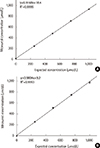Abstract
Background
Diabetes mellitus and alcohol consumption are the most common causes of ketoacidosis in adults. Recently, β-hydroxybutyric acid (βHBA) was reported to be a potential serum biomarker in the diagnosis and monitoring of ketoacidosis. We evaluated the performance of T-KB-H and 3-HB kits for the measurement of ketone bodies [acetoacetate (AcAc)+βHBA] and βHBA, respectively.
Methods
Quantitative enzymatic assays were performed using the T-KB-H and 3-HB kits (Nittobo Medical Co., Japan) and the Architect ci16200 Integrated System (Abbott Laboratories, USA). Simultaneously, the ketone body levels in these serum samples were determined by gas chromatography-mas spectrometry (GC-MS). We evaluated precision and linearity of these kits and correlation with GC-MS, and established reference intervals in children and adults.
Results
The coefficients of variation for the T-KB-H and 3-HB kits were less than 4.0% at analyte levels of 50, 100, and 400 µmol/L. Linearity was observed for AcAc and βHBA over a 0-1,000 µmol/L range (R2<0.99). Results from the T-KB-H and 3-HB kits were in good agreement with those from the GC-MS analysis, with correlation coefficients of 0.94 for AcAc and 0.96 for βHBA. Reference intervals determined for the T-KB-H kit were 9.8-270.1 µmol/L and 18.5-531.8 µmol/L in children and adults, respectively. For the 3-HB kit, the reference intervals were 6.4-234.0 µmol/L and 16.0-437.2 µmol/L in children and adults, respectively.
Figures and Tables
Fig. 1
Linearity of concentrations measured by the T-KB-H kit. (A) β-hydroxybutyric acid, (B) acetoacetate.

Fig. 3
Comparison of acetoacetate (AcAc) and β-hydroxybutyric acid (βHBA) measurements obtained with the T-KB-H kit, the 3-HB kit, and gas chromatography-mass spectrometry (GC-MS). (A) and (C), Scatter plots with ordinary linear fit with the Passing-Bablock regression analysis for AcAc and βHBA. (B) and (D), Bland-Altman plots for AcAc and βHBA.

References
1. Laffel L. Ketone bodies: a review of physiology, pathophysiology and application of monitoring to diabetes. Diabetes Metab Res Rev. 1999; 15:412–426.

2. Sacks DB, Arnold M, Bakris GL, Bruns DE, Horvath AR, Kirkman MS, et al. Guidelines and recommendations for laboratory analysis in the diagnosis and management of diabetes mellitus. Diabetes Care. 2011; 34:e61–e99.

3. Helander A, Beck O, Jones AW. Laboratory testing for recent alcohol consumption: comparison of ethanol, methanol, and 5-hydroxytryptophol. Clin Chem. 1996; 42:618–624.

4. Hassan HM, Cooper GA. Determination of β-hydroxybutyrate in blood and urine using gas chromatography-mass spectrometry. J Anal Toxicol. 2009; 33:502–507.

5. Marliss EB, Ohman JL Jr, Aoki TT, Kozak GP. Altered redox state obscuring ketoacidosis in diabetic patients with lactic acidosis. N Engl J Med. 1970; 283:978–980.

7. Clinical and Laboratory Standards Institute. EP05-A2. Evaluation of precision performance of quantitative measurement methods; approved guideline. 2nd ed. Wayne, PA: Clinical and Laboratory Standards Institute;2004.
8. Clinical and Laboratory Standards Institute. Evaluation of the linearity of quantitative measurement procedures: a statistical approach; approved guideline. EP6-A. Wayne, PA: Clinical and Laboratory Standards Institute;2003.
9. Clinical and Laboratory Standards Institute. Method comparison and bias estimation using patient samples; Approved Guideline. EP9-2. 2nd ed. Wayne, PA: Clinical and Laboratory Standards Institute;2002.
10. Sheikh-Ali M, Karon BS, Basu A, Kudva YC, Muller LA, Xu J, et al. Can serum β-hydroxybutyrate be used to diagnose diabetic ketoacidosis? Diabetes Care. 2008; 31:643–647.

11. Yu HY, Agus M, Kellogg MD. Clinical utility of Abbott Precision Xceed Pro® ketone meter in diabetic patients. Pediatr Diabetes. 2011; 12:649–655.

12. Burtis CA, Ashwood ER, editors. Tietz textbook of clinical chemistry and molecular diagnostics. 5th ed. St.Louis: Saunders/Elsevier;2012. p. 1440–1441.
13. Mitchell GA, Kassovska-Bratinova S, Boukaftane Y, Robert MF, Wang SP, Ashmarina L, et al. Medical aspects of ketone body metabolism. Clin Invest Med. 1995; 18:193–216.




 PDF
PDF ePub
ePub Citation
Citation Print
Print




 XML Download
XML Download